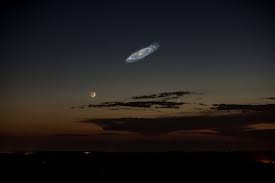A quick video to look at some galaxies
What are they?
Most galaxies are shaped a bit like a discus. They contain billions, sometimes trillions of stars. An estimate of the number in our own “Milky Way” galaxy is between 100-400 billion starts. Its diameter is almost 2 million light years. The disk is about 2000 light years thick. The milky way itself is what we see when we look within the discus shape towards its edge. We see many more stars than if we look in a direction perpendicular to this just through the thickness of the discus. If we look with a small telescope the individual stars in the milky way became visible.
Where are they?
The Andromeda nebula is about 2.5 million light years from us and contains about a trillion stars, about twice as many as in our Milky Way.
Although it was discovered in 1917 that novae in Andromeda were 10 magnitudes fainter than those in the Milky Way, there was still a debate in 1920 about whether the Andromeda galaxy was within the Milky Way. The great distance of Andromeda and the idea of it as an “island universe” was confirmed by Hubble in 1923 using cephid variables. (Cephid variable stars, which are thousands of times more luminous than the Sun, provide us with such a benchmark, known in astronomy as a “standard candle”. By observing the variability period of any Cephid, you can deduce its absolute brightness. Then from the actual brightness you can work out the distance)
We now know there are huge numbers of galaxies from comparatively close like Andromeda (2.5 million light years) to the very edge of the visible universe at about 47 billion light years.
What are we looking at?
When we observe a galaxy with an amateur telescope, we see a fuzz. This is not a fuzz as we see in a nebula (put link to nebula page here). If we could zoom in we would see the fuzz resolve into individual stars generally with distances between then in the order of light years. The nearest star from us in our galaxy is Proxima Centuri at a distance of 4.2 light years. Also the stars tend to form in shapes as in the classic spiral galaxy where the stars tend to congregate into arms spiraling out from the centre.
The great nebula in Andromeda is the nearest galaxy to us. On a clear dark night, we can just make out the bright central core. But the total apparent size is much bigger. If we had much more sensitive eyes this is how big it would look in relation to the moon.

Types of Galaxy
Not all galaxies are spiral, some are irregular or just have symmetry but with a spiral structure. There are also elliptical galaxies. In some galaxies, in addition to being spiral, they also have a central bar. A special class of spiral galaxies is the “grand design” category with prominent and well-defined spiral arms, as opposed to multi-arm and more “fluffy” spirals which have subtler structural features. Why, and how these structures arise can be found by an internet search.